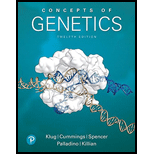
EBK CONCEPTS OF GENETICS
12th Edition
ISBN: 9780134818979
Author: Killian
Publisher: YUZU
expand_more
expand_more
format_list_bulleted
Concept explainers
Textbook Question
Chapter 6, Problem 13PDQ
Two theoretical genetic strains of a virus (a−b−c− and a+b+c+) were used to simultaneously infect a culture of host bacteria. Of 10,000 plaques scored, the following genotypes were observed. Determine the genetic map of these three genes on the viral chromosome. Decide whether interference was positive or negative.

Expert Solution & Answer
Want to see the full answer?
Check out a sample textbook solution
Students have asked these similar questions
4. This question focuses on entrainment.
a. What is entrainment?
b. What environmental cues are involved in entrainment, and which one is most influential?
c. Why is entrainment necessary?
d. Assuming that a flash of darkness is an effective zeitgeber, what impact on circadian
rhythms would you expect to result from an event such as the 2024 solar eclipse (assume
it was viewed from Carbondale IL, where totality occurred at about 2 pm)? Explain your
reasoning. You may wish to consult this phase response diagram.
Phase Shift (Hours)
Delay Zone
Advance Zone
Dawn
Mid-day
Dusk
Night
Dawn
Time of Light Stimulus
e. Finally, give a real-world example of how knowledge of circadian rhythms and
entrainment has implications for human health and wellbeing or conservation biology.
This example could be from your reading or from things discussed in class.
Generate one question that requires a Punnet Squre to solve the question. Then show how you calculate the possibilities of genotype and phenotype
Briefly state the physical meaning of the electrocapillary equation (Lippman equation).
Chapter 6 Solutions
EBK CONCEPTS OF GENETICS
Ch. 6 - When the interrupted mating technique was used...Ch. 6 - In a transformation experiment involving a...Ch. 6 - In complementation studies of the rII locus of...Ch. 6 - A 4-month-old infant had been running a moderate...Ch. 6 - Prob. 2CSCh. 6 - Prob. 3CSCh. 6 - Prob. 4CSCh. 6 - HOW DO WE KNOW? In this chapter, we have focused...Ch. 6 - Review the Chapter Concepts list on p. 123. Many...Ch. 6 - With respect to F+ and F bacterial matings, answer...
Ch. 6 - List all major differences between (a) the F+ F...Ch. 6 - Describe the basis for chromosome mapping in the...Ch. 6 - In general, when recombination experiments are...Ch. 6 - Why are the recombinants produced from an Hfr F...Ch. 6 - Describe the origin of F bacteria and merozygotes.Ch. 6 - In a transformation experiment, donor DNA was...Ch. 6 - Describe the role of heteroduplex formation during...Ch. 6 - Explain the observations that led Zinder and...Ch. 6 - Prob. 12PDQCh. 6 - Two theoretical genetic strains of a virus (abc...Ch. 6 - The bacteriophage genome consists of many genes...Ch. 6 - If a single bacteriophage infects one E. coli cell...Ch. 6 - A phage-infected bacterial culture was subjected...Ch. 6 - In recombination studies of the rII locus in phage...Ch. 6 - In an analysis of rII mutants, complementation...Ch. 6 - If further testing of the mutations in Problem 18...Ch. 6 - Using mutants 2 and 3 from Problem 19, following...Ch. 6 - During the analysis of seven rII mutations in...Ch. 6 - In studies of recombination between mutants 1 and...Ch. 6 - Prob. 23ESPCh. 6 - An Hfr strain is used to map three genes in an...Ch. 6 - A plaque assay is performed beginning with 1 mL of...Ch. 6 - In a cotransformation experiment, using various...Ch. 6 - For the experiment in Problem 26, another gene, g,...Ch. 6 - Bacterial conjugation, mediated mainly by...Ch. 6 - A study was conducted in an attempt to determine...
Knowledge Booster
Learn more about
Need a deep-dive on the concept behind this application? Look no further. Learn more about this topic, biology and related others by exploring similar questions and additional content below.Similar questions
- Explain in a small summary how: What genetic information can be obtained from a Punnet square? What genetic information cannot be determined from a Punnet square? Why might a Punnet Square be beneficial to understanding genetics/inheritance?arrow_forwardIn a small summary write down:arrow_forwardNot part of a graded assignment, from a past midtermarrow_forward
- Noggin mutation: The mouse, one of the phenotypic consequences of Noggin mutationis mispatterning of the spinal cord, in the posterior region of the mouse embryo, suchthat in the hindlimb region the more ventral fates are lost, and the dorsal Pax3 domain isexpanded. (this experiment is not in the lectures).a. Hypothesis for why: What would be your hypothesis for why the ventral fatesare lost and dorsal fates expanded? Include in your answer the words notochord,BMP, SHH and either (or both of) surface ectoderm or lateral plate mesodermarrow_forwardNot part of a graded assignment, from a past midtermarrow_forwardNot part of a graded assignment, from a past midtermarrow_forward
arrow_back_ios
SEE MORE QUESTIONS
arrow_forward_ios
Recommended textbooks for you
 Biology: The Dynamic Science (MindTap Course List)BiologyISBN:9781305389892Author:Peter J. Russell, Paul E. Hertz, Beverly McMillanPublisher:Cengage Learning
Biology: The Dynamic Science (MindTap Course List)BiologyISBN:9781305389892Author:Peter J. Russell, Paul E. Hertz, Beverly McMillanPublisher:Cengage Learning Concepts of BiologyBiologyISBN:9781938168116Author:Samantha Fowler, Rebecca Roush, James WisePublisher:OpenStax College
Concepts of BiologyBiologyISBN:9781938168116Author:Samantha Fowler, Rebecca Roush, James WisePublisher:OpenStax College Biology Today and Tomorrow without Physiology (Mi...BiologyISBN:9781305117396Author:Cecie Starr, Christine Evers, Lisa StarrPublisher:Cengage Learning
Biology Today and Tomorrow without Physiology (Mi...BiologyISBN:9781305117396Author:Cecie Starr, Christine Evers, Lisa StarrPublisher:Cengage Learning Biology (MindTap Course List)BiologyISBN:9781337392938Author:Eldra Solomon, Charles Martin, Diana W. Martin, Linda R. BergPublisher:Cengage Learning
Biology (MindTap Course List)BiologyISBN:9781337392938Author:Eldra Solomon, Charles Martin, Diana W. Martin, Linda R. BergPublisher:Cengage Learning


Biology: The Dynamic Science (MindTap Course List)
Biology
ISBN:9781305389892
Author:Peter J. Russell, Paul E. Hertz, Beverly McMillan
Publisher:Cengage Learning


Concepts of Biology
Biology
ISBN:9781938168116
Author:Samantha Fowler, Rebecca Roush, James Wise
Publisher:OpenStax College

Biology Today and Tomorrow without Physiology (Mi...
Biology
ISBN:9781305117396
Author:Cecie Starr, Christine Evers, Lisa Starr
Publisher:Cengage Learning

Biology (MindTap Course List)
Biology
ISBN:9781337392938
Author:Eldra Solomon, Charles Martin, Diana W. Martin, Linda R. Berg
Publisher:Cengage Learning
Molecular Techniques: Basic Concepts; Author: Dr. A's Clinical Lab Videos;https://www.youtube.com/watch?v=7HFHZy8h6z0;License: Standard Youtube License